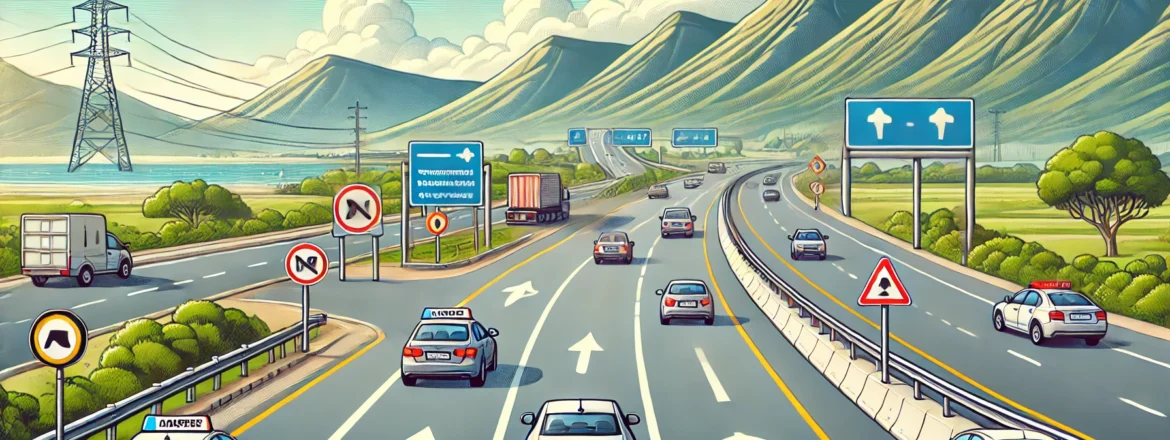Driving on multi-lane highways can be intimidating, especially for new drivers. However, with the right knowledge and techniques, you can handle these roads with confidence. In the Western Cape, highways like the N1, N2, and R300 require alertness and skill. This guide will help you navigate multi-lane highways safely while boosting your confidence behind the wheel.
Table of Contents
- Understand Lane Discipline
- Plan Ahead for Exits
- Master the Art of Merging
- Maintain a Safe Following Distance
- Overtaking Correctly
- Be Aware of Speed Limits
- Dealing with Roadworks and Hazards
- Stay Focused and Avoid Distractions
- Practice Defensive Driving
1. Understand Lane Discipline
Lane discipline is essential when driving on multi-lane highways. Always keep to the left lane unless you are overtaking. This not only helps traffic flow smoothly but also prevents accidents. In South Africa, the “Keep Left, Pass Right” rule applies.
Using the correct lane also helps drivers preparing to enter or exit the highway. Avoid lingering in the middle or right-hand lanes unnecessarily.
2. Plan Ahead for Exits
Exiting a multi-lane highway can become stressful if you’re not prepared. Watch for signage indicating your exit at least 2 km in advance. Begin transitioning to the appropriate lane early to avoid last-minute swerving.
Missed your exit? Don’t panic or make sudden stops. Continue to the next exit and safely turn back.
3. Master the Art of Merging
Joining a highway from an on-ramp requires good judgment. Accelerate to match the highway’s speed before merging, and always check your mirrors and blind spots.
Yield to vehicles already on the highway, but don’t stop at the end of the on-ramp unless absolutely necessary. A smooth merge ensures safety for everyone.
4. Maintain a Safe Following Distance
Tailgating is one of the main causes of accidents on highways. Always maintain a safe following distance. A good rule of thumb is the “3-second rule.” Pick a fixed point on the road, and when the car ahead passes it, count three seconds before your car reaches the same point.
If you’re driving in bad weather or heavy traffic, increase this distance to at least five seconds.
5. Overtaking Correctly
When overtaking, use the right lane and return to the left once you’ve passed the vehicle. Avoid cutting back into the lane too quickly, as this can force the driver behind to brake suddenly.
Signal your intentions clearly before changing lanes, and check your mirrors and blind spots for any fast-approaching vehicles.
6. Be Aware of Speed Limits
Speed limits on South African highways typically range between 100 and 120 km/h. However, some sections may have lower limits due to construction or other hazards.
Obeying speed limits is crucial for safety and avoiding fines. Driving too fast reduces your reaction time, while driving too slowly can disrupt traffic flow and cause accidents.
7. Dealing with Roadworks and Hazards
The Western Cape highways often experience roadworks and other temporary hazards. Pay attention to warning signs and slow down accordingly.
Keep an eye out for sudden lane closures and workers near the road. Give yourself extra time to reach your destination when traveling through construction zones.
8. Stay Focused and Avoid Distractions
Highway driving demands full concentration. Avoid using your phone, eating, or fiddling with the radio while driving.
If you need to adjust something or take a break, use designated rest stops or pull over safely. Distractions can lead to severe accidents, especially on high-speed roads.
9. Practice Defensive Driving
Defensive driving involves anticipating potential hazards and being ready to react. For example:
- Watch out for vehicles suddenly changing lanes.
- Keep an eye on trucks and buses with wide blind spots.
- Be cautious around reckless drivers and give them space.
By staying alert and planning for the unexpected, you can reduce risks on multi-lane highways.
FAQs
1. What is the best way to stay in the correct lane on highways?
Stick to the left lane unless overtaking. Use road signs to plan ahead for exits or turns.
2. How can I build confidence driving on highways?
Practice during off-peak hours with a driving instructor or experienced driver. Gradually build your skills over time.
3. Why is merging onto highways so challenging?
Merging requires matching speed with traffic and good timing. Focus on checking your mirrors, signaling, and avoiding hesitation.
4. Are there special tips for highways in the Western Cape?
Be prepared for changing weather conditions and roadworks. Watch out for sudden wind gusts, especially on coastal highways.
Conclusion
Driving on multi-lane highways in the Western Cape doesn’t have to be stressful. By following these tips, you’ll improve your confidence and stay safe on the road. Whether you’re commuting or planning a road trip, practicing these skills will make your journey smoother.
For professional drivers’ training near you, iDriving School offers courses that include highway driving lessons. Get in touch today to master highway driving and more!


